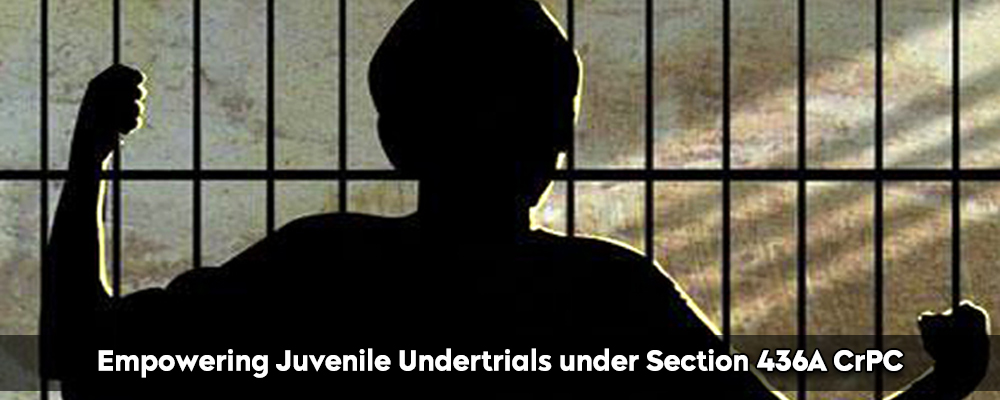The Indian criminal justice system has always grappled with the delicate balance between punishing offenders and safeguarding the rights of those accused, especially in the case of juveniles. One critical aspect that pertains to this balance is the question of whether juveniles can avail the benefits of Section 436A of the Code of Criminal Procedure (CrPC) during their undertrial period.
Section 436A: Code of Criminal Procedure
Section 436A of the Code of Criminal Procedure, 1973, was introduced with the aim of addressing the plight of undertrial prisoners languishing in jails for extended periods while their cases are pending. The provision was incorporated in 2005 to provide relief to prisoners who have undergone the maximum term of imprisonment for the offense they were charged with during their trial period. It seeks to prevent unnecessary detention and grant bail to those prisoners, thus ensuring their right to liberty and a fair trial.
Need A Legal Advice
The internet is not a lawyer and neither are you. Talk to a real lawyer about your legal issue

How can Juvenile get Benefit of Sec 436A CrPC on undertrial Period?
Section 436A was introduced to address the issue of undertrial prisoners languishing in jails for extended periods without being convicted of any crime. Here’s how a juvenile can get the benefit of this provision-
Age Verification
The first and most crucial requirement is establishing that the individual is indeed a juvenile, i.e., below the age of 18 years. Age verification is typically conducted by the juvenile justice board or the court, considering relevant documents and expert opinions, if necessary.
Maximum Undertrial Period
Section 436A CrPC comes into play when an undertrial prisoner has completed the maximum period of imprisonment for the offense they are charged with during their trial period. For instance, if the maximum punishment for the crime is three years and the juvenile has already spent three years as an undertrial, they become eligible to apply for bail under this provision.
Non-involvement in Serious Offenses
The benefit of Section 436A CrPC is generally extended to those who are accused of relatively minor or non-heinous offenses. If the juvenile is charged with grave crimes, such as murder, rape, or offenses punishable with life imprisonment or death penalty, they might not be eligible for bail under this provision.
Legal Representation
Having legal representation is crucial for the juvenile’s case. A competent lawyer can argue the case effectively before the juvenile justice board or the court and present compelling reasons for granting bail under Section 436A CrPC.
Application for Bail
To avail the benefit of Section 436A, a formal application for bail must be filed before the appropriate juvenile justice board or court. The application should detail the relevant facts and present arguments supporting the grant of bail based on the completion of the maximum undertrial period.
Best Interest of the Child
The primary consideration in any juvenile case is the best interest of the child. The court or the juvenile justice board will assess the juvenile’s background, circumstances, and potential for rehabilitation before deciding on the bail application.
Supportive Social Investigation Report
A social investigation report is often prepared to understand the juvenile’s background, family situation, and social environment. A positive report, highlighting the suitability for reintegration into society, can strengthen the case for bail.
Guarantees and Sureties
Depending on the requirements of the case, the court or the juvenile justice board may ask for guarantees or sureties to ensure the juvenile’s appearance during trial proceedings.
Role of Judiciary: Supreme Court
In the case of VK Juvenile v State of Rajasthan, the issue revolved around a juvenile accused of a serious offense, detained for an extended period as an undertrial. The central question was whether the juvenile could avail the benefits of Section 436A CrPC, which would entitle him to be released on bail if he had already undergone the maximum term of imprisonment for the offense during the undertrial period.
Supreme Court’s Deliberation
Supreme Court faced dilemma extending Sec 436A CrPC to juvenile undertrials which was a novel and complex issue that required a nuanced approach.
The Court acknowledged the delicate nature of juvenile cases, emphasizing the constitutional duty to protect their rights and welfare. Prolonged detention’s impact on young minds and potential adverse consequences on reformation and integration were also considered.
Despite the absence of a clear precedent on the matter, the Court demonstrated its empathy and concern for the juvenile’s plight. Recognizing the principle of “bail, not jail,” it granted bail to the young accused while leaving the broader question open for future consideration.
While the Court’s decision to grant bail showcased its concern for juvenile rights, it also underscored the need for a comprehensive review of the applicability of Section 436A CrPC to juveniles. As the matter remains unresolved, it is essential for lawmakers and legal experts to engage in extensive deliberations to determine the most appropriate approach.
One can talk to a lawyer at Lead India for any kind of legal advice. In India, free legal advice online is available by Lead India. Along with getting free legal advice online, you can ask questions to experts online free at Lead India.





 Talk to a Lawyer
Talk to a Lawyer